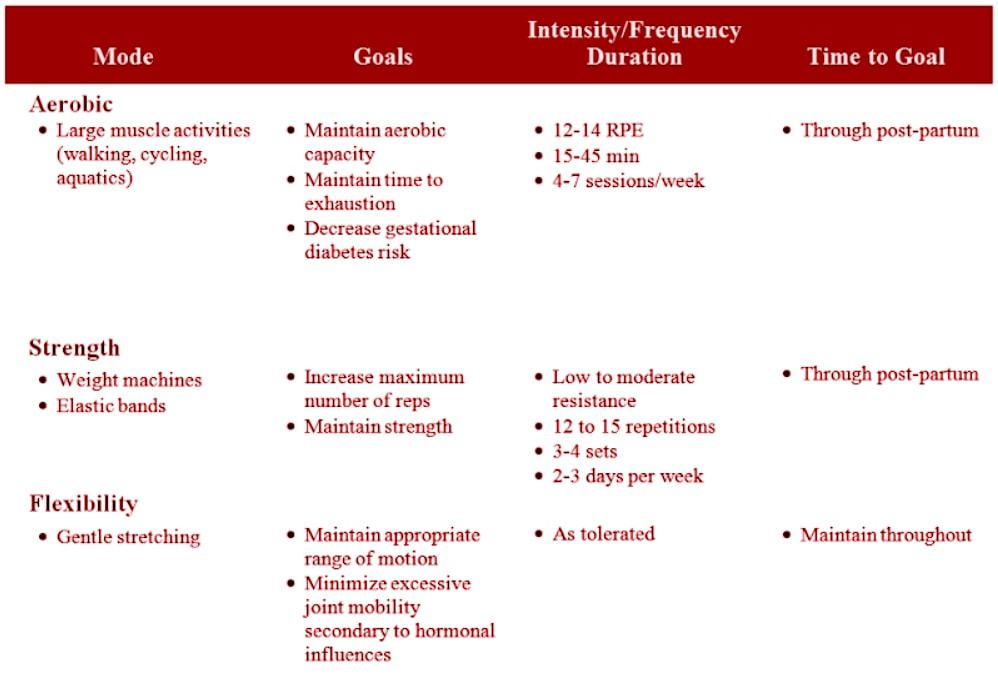Programming for Pregnancy
According to the American College of Obstetricians and Gynecologists, regular exercise is promoted for its overall health benefits. Although pregnancy is associated with profound anatomical and physiological changes, there are a few instances that should preclude pregnant women from exercising daily. Exercise prescription should include some modifications in terms of mode, musculoskeletal factors and flexibility exercises.
Changes in body size and structure have the potential to impact the musculoskeletal system during pregnancy. Theoretically, weight gain associated with pregnancy may significantly increase the forces across joint surfaces by as much as 100% during weight-bearing activities. In reality, there is little or no evidence that supports abnormal joint function during pregnancy. However, changes in the center of mass have a profound effect on posture and most pregnant women develop excessive lumbar lordosis during pregnancy. This may contribute to the greater than 50% incidence of low back pain experienced during pregnancy. General joint laxity also increases during pregnancy resulting from an increased level of circulating relaxin. No clear evidence suggests there is an increase in musculoskeletal injuries during pregnancy.
Cardiovascular adaptations are profound during pregnancy. Changes include an increase in blood volume, heart rate, stroke volume and a decrease in systemic vascular resistance. Cardiac output increases 30-50% of the pre-pregnancy level by the midpoint of gestation. Changes in hemodynamics appear to establish a reserve to provide the fetus and mother with adequate oxygen and nutrients during rest and moderate activity. Supine posture should be avoided as it obstructs venous return as does prolong, motionless standing. There are conflicting data on maternal heart rate response to exercise. As such, heart rate monitoring is less desirable to determine appropriate exercise intensities.
The cardiovascular system is affected the most during pregnancy by the increased metabolic demands associated with exercise. This is a major factor in the dissipation of the excess heat generated by exercise. Normally, maternal core temperature will elevate 1.5oC during the first thirty minutes of exercise in a thermoneutral environment reaching a plateau for the next thirty minutes. As long as heat production is matched by dissipation, there is minimal risk. However, if maternal core temperature is elevated above 1.5oC during embryonic development, major congenital malformations have been observed.
Absolute and relative contraindications for exercise exist in pregnancy.
Absolute contraindications include:
- Hemodynamically significant heart disease
- Restrictive lung disease
- Incomplete cervix
- Multiple gestations at risk for premature labor
- Persistent second or third trimester bleeding
- Placenta previa after 26 weeks of gestation
- Premature labor
- Ruptured membranes
- Pregnancy-induced hypertension
Relative contraindications to aerobic exercise during pregnancy include:
- Severe anemia
- Unevaluated maternal cardiac arrhythmia
- Chronic bronchitis
- Poorly controlled type I diabetes
- Extreme morbid obesity
- Extreme underweight (BMI <12)
- History of an extremely sedentary lifestyle
- Intrauterine growth restriction in current pregnancy
- Poorly controlled hypertension/preeclampsia
- Orthopedic limitations
- Poorly controlled seizure disorder
- Poorly controlled thyroid disease
- Heavy smoker
Once an individual has been cleared for exercise by her physician an exercise prescription can be developed to provide a framework for progression through the pre and post-partum period. Consideration should be given during the development of the exercise program as to the previous level of activity, competitive nature and any risk factors associated with the individual. Aerobic exercise mode should include activities that are familiar to the client. Walking, stationary cycling and swimming are appropriate. Exercise intensity is the most difficult component to prescribe for pregnant women. As heart rate monitoring becomes less reliable to judge workload, utilizing the rate of perceived exertion is recommended. Maintaining an RPE between12-14 (6-20 scale) is ideal for optimal benefit. Upper-level safe exercise intensity has not been established. Consequently, women who were regular exercisers before becoming pregnant and have no complications should be able to engage in higher intensity programs. Duration of exercise sessions should be between 30 and 45 minutes. Longer than 45 minutes brings up concerns of thermoregulation and energy balance. Exercise sessions are encouraged daily.
Pregnancy is not a time to greatly increased one’s fitness level. Progression in otherwise sedentary individuals should gradually work up to 30 minutes per day. In women who were active and training prior to becoming pregnant, they should expect their overall fitness and activity level to slowly decline over the course of the pregnancy.
Check out these other posts to learn more about training Special Populations, including those with Hypertension, CAD, Type I and Type II diabetes, asthma, autoimmune disorders, and children and teens.
PS: Don’t forget to check out the Personal Fitness Trainer course.










